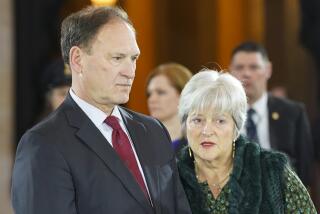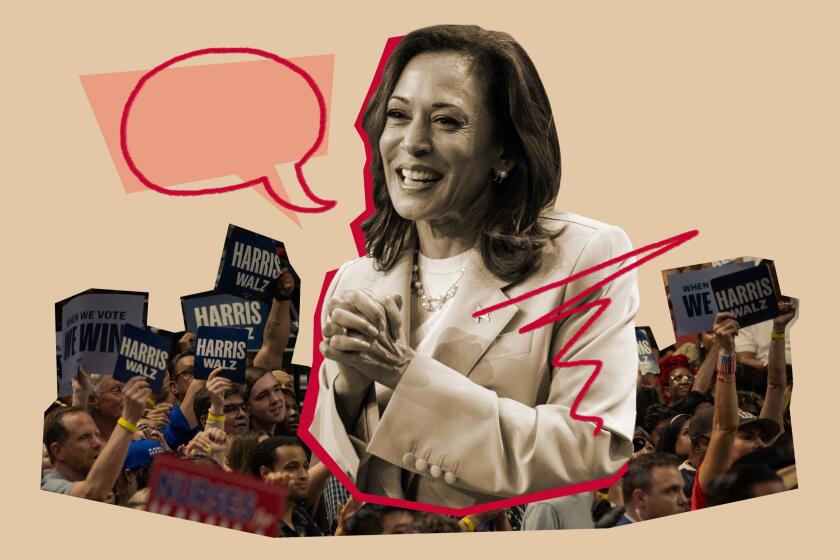Court Looks at Race Bias on Juries
WASHINGTON -- The Supreme Court was asked Wednesday to end the lingering race bias on juries by putting trial judges and prosecutors on notice that blacks may not be questioned differently from whites when potential jurors are being selected.
More than a century ago, the high court said states may not exclude blacks from juries. But ending all such discrimination has proved to be surprisingly difficult.
Former U.S. Solicitor Gen. Seth Waxman challenged the justices to reverse the death sentence given a Texas murderer, saying racial bias tainted the man’s jury.
“This is truly an exceptional case,” Waxman said. “Whatever this court decides, this case is going to stand as a benchmark” in the long struggle to abolish racial discrimination in courts.
The defendant, Thomas Miller-El, came within days of being executed in February. The high court blocked the execution and then agreed to review the case because it raised a troubling issue from the past.
Only one of the 12 people who served on the Dallas jury that tried the accused murderer in 1986 was black. Miller-El is black, and he was charged with robbing, tying up and shooting two white clerks at a Holiday Inn. One died. The other lived and testified against him.
There seemed to be little doubt of Miller-El’s guilt, and prosecutors were determined to win a death sentence. They excluded 10 of the 11 African Americans who were prepared to serve on the jury.
Nonetheless, a Dallas judge, the Texas state courts and the U.S. Court of Appeals in New Orleans all rejected claims that race bias may have infected the jury.
At one level, the case (Miller-El vs. Cockrell) raises a recurring problem. How can judges tell the difference between a prosecutor’s legitimate hunch and an illegitimate racial bias?
In selecting juries, prosecution and defense lawyers are both free to exclude an equal number of potential jurors. They are entitled to look at and question potential jurors and eliminate them based on suspicions that they will be biased against their case.
However, race may not be the basis for this suspicion, the high court stressed in 1986, ruling in Batson vs. Kentucky. That decision said trial judges should question prosecutors who turn away an unusual number of blacks from the jury.
The case heard Wednesday tests how the Batson decision is supposed to work in practice.
The blacks who were dropped from the Dallas jury in 1986 were excluded “because of their views, not because of their race,” Gena Bunn, a Texas state attorney, told the justices.
Under the law, prosecutors may exclude potential jurors “with unfavorable views of the death penalty, regardless of their race,” she said in her brief. “The vast majority of African American panelists [who came for jury service in the 1986 trial] were either opposed to the death penalty or were unwilling to impose it.”
But Waxman and the Texas defense lawyers disputed that view. They pointed to a history of blatant racial bias in Dallas County and a continuing practice of subtle discrimination.
Henry Wade served as the Dallas district attorney from 1951 to 1987, and he insisted his prosecutors keep minorities off of juries.
“Do not take Jews, Negroes, Dagos, Mexicans or a member of any minority race on a jury, no matter how rich or how well educated. They will not do on juries,” prosecutors were told in a 1963 manual.
Later editions revised that language but maintained the same message. “Minority races almost always empathize with the defendant,” and should be excluded where possible, according to a manual that was used as late as the early 1980s.
A Dallas Morning News study published in 1986, the year of the Miller-El trial, found more than nine in 10 African Americans who were available to serve on juries were excluded.
A black person who was “hesitant [about the death penalty] was 3 1/2 times more likely to be struck” from the jury than a white person who expressed the same view, Waxman said.
Most of the justices signaled they are likely to side with Miller-El and against the Texas prosecutors.
“The historical evidence is very persuasive, overwhelming,” Justice Anthony M. Kennedy said. And the pattern of questioning is “strong circumstantial evidence” of racial bias on the part of the prosecutors.
If this case does not warrant a reversal, “you could never have a successful Batson challenge,” added Justice Ruth Bader Ginsburg. “A prosecutor could always give a neutral reason” for excluding a black person from the jury, she said.
Only Chief Justice William H. Rehnquist openly sided with the Texas prosecutors.
“You have two strong presumptions going against you,” he told Waxman. He was referring to past rulings and recent laws saying federal judges should defer to trial judges and state courts that reviewed the evidence.
But Rehnquist was one of only two dissenters from the 1986 Batson ruling that required judges to question prosecutors who exclude too many blacks from a jury.
The case appeared to be one of rare instances in which the chief justice stood in the distinct minority on the court.
A ruling on the issue can be expected in several months.
More to Read
Get the L.A. Times Politics newsletter
Deeply reported insights into legislation, politics and policy from Sacramento, Washington and beyond. In your inbox three times per week.
You may occasionally receive promotional content from the Los Angeles Times.











